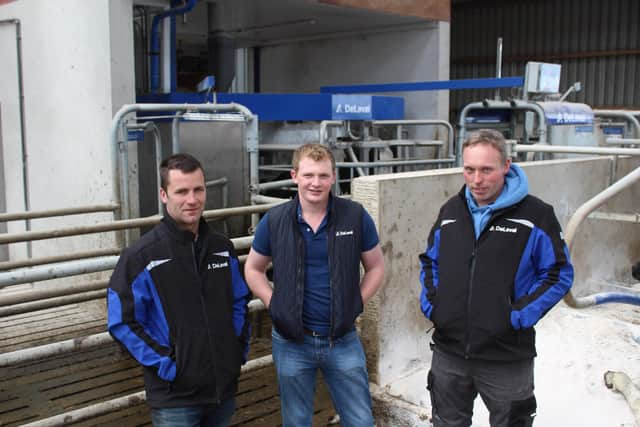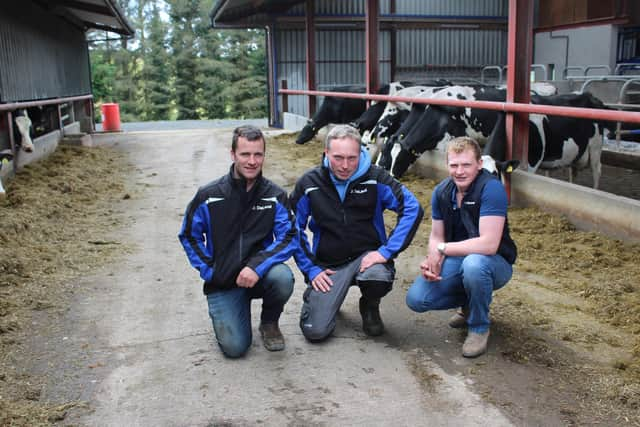The growth in robotic milking systems continues apace
and live on Freeview channel 276
Having an in-depth knowledge of cows, particularly when it comes to the challenge of calving animals successfully, is an invaluable skills-set to possess.
The availability of good sheds is another advantage that can be brought to bear when transitioning to milk production.
Advertisement
Advertisement
But for many new entrants into dairy, an investment in robotic milking technology helps to complete the process in ways that delivers total confidence on the part of the farmers involved.


Within a robotic regime, the farmer knows that the cows will be milked to the highest standards on a consistent basis.
It’s also an approach to dairy farming that allows those involved to totally concentrate on the precision management of the cows, thanks to the real time information available to them on a 24:7 basis.
Hugh McCambridge is a case in point.
He farms on the outskirts of Glenarm in Co Antrim.


Up to three years ago, suckler beef was the main enterprise on the family farm. Today, Hugh is milking 130 cows, using two DeLavalV300 robotic systems.
Advertisement
Advertisement
He explained: “We recognised that dairy would help improve the finances of the farm as a whole.
"Our home farm is located close to Carnlough. But this is a hill enterprise, which is best suited to sheep.
“However, we did have the option of switching the focus of the land at Glenarm to dairy. And this is the road that we have decided to go down.”
According to Hugh, he had been thinking for quite some about dairying and knew that it would be part of his future.
Advertisement
Advertisement
He continued:“The first cows were milked at Glenarm in January 2020. But there was a full year of preparation required to get us to that stage.
“This included the conversion of the suckler house that had been on the site.”
Last year, Hugh committed to putting a second cubicle house and robotic milking system in place.
“It’s the mirror image of the first unit, which means that we have the two robots working in different sheds,” he explained.
Advertisement
Advertisement
“Given the layout of the overall site, this was the most efficient way of adding another shed to expand cow numbers with an additional robot ”
The two units have a similar footprint. One is 130’ by 65’: the other is 130’ by 82’. The slightly broader shed also incorporates dry cow and calving areas.
Once a cow has been established on a particular robot, she will stay there with the batch and robot she is familiar with.
He continued:“Prior to the development of the second unit, we had just over 70 cows being milked by the initial robot.
"At that stage, it was working at its peak capacity.”
Advertisement
Advertisement
According to Hugh, a key selling point of the DeLaval milking system was the availability of the accompanying Feed First Cow Traffic system.
He explained: “All the cows receive a total mixed ration. This comprises a mix of grass silage, wholecrop and four kilos of blend. Beyond that, the robot takes over and ensures that each animal is fed to yield.
“All of this is driven by the DeLaval Delpro ‘Feed to Yield’ management system. This ensures that feeding rates are stepped or reduced, depending on her daily milk output and stage of lactation.
“The cows are offered nuts while milking. Out-of-parlour feeders are also available in the cubicle house to top up the cows’ allocation.
Advertisement
Advertisement
“This avoids overfeeding in the robot which can increase box time and reduce the output of the system.”
Another key feature of the Feed First system is the series of selection sort gates in the shed. These act to only permit the one-way movement of the cows.
It also means that only the cows that have permission to milk will gain access to the robot. If a cow is not due to be milked, she will be returned to the cubicles.
The end result is a significant boost to the efficiency of the combined feeding and milking system.
Advertisement
Advertisement
The McCambridge herd is averaging just short of 10,000L per lactation.
Breeding herd replacements is a key priority for the business.
“Yes, we are breeding for more milk and better constituents,” Hugh confirmed.
“But securing improved mobility is our most important priority in this regard.
Advertisement
Advertisement
"Good legs and feet are crucially important within a robotic milking system, particularly when the cows are housed throughout their lactations.
“Good teat placement is also important for cows on robotic milking systems.
"It’s all about having cows that have capacity to milk well and then allowing them to meet this potential.
“The current replacement rate is around 15%. Our own heifers are coming through now.
Advertisement
Advertisement
"The aim moving forward is to be as self sufficient as possible from a breeding perspective.
“Good quality Holstein bulls are used alongside some AI Sexed semen to breed the replacements, with an Angus bull to sweep up.”
Hugh is also quick to confirm that a commitment to robotic milking entails a significant investment on the part of the farmers involved.
He said:“Robots are not cheap, either to buy or maintain. They are designed to milk cows with a high output capacity.
Advertisement
Advertisement
"And this level of output is required to ensure that the investment and running costs can be justified.”
So why did Hugh commit to a robotic milking system in the first place?
“There were two main reasons driving this decision,” he explained.
“In the first instance, we still run our hill sheep enterprise on a separate farmyard.
Advertisement
Advertisement
“So, logistically, this made the robotic system more appealing as a means of getting into dairy.
“In addition, I have a young family. The tremendous benefit of a robot is that it allows me make use of my time in a more flexible manner.
“The robots are also very good at extracting large volumes of milk from cows. And all of this is being achieved on a totally consistent basis.”
The DeLaval Delpro management system supplies Hugh with data that is available on both my phone and the farm computer.
Advertisement
Advertisement
He explaines: “The robot records the milk produced from each individual quarter on every cow throughout her lactation.
“The robot is also picking up cell count and mastitis-related issues at a very early stage. This is a direct result of the milk conductivity data which, again, is available on a real time basis.”
Labour availability is more than significant challenge on dairy farms across Northern Ireland at the present time.
“This is another reason why I opted for a robotic milking system,” Hugh confirmed.
Advertisement
Advertisement
“The current group of cows are producing a fair amount of milk. The priority is to manage them well.
"I am happy that the current scope of the system which is allowing me to achieve this objective.
“The robots potentially have the capacity to cope with more numbers but that’s not part of my plan as I see merit in not pushing the system to milk more cows, which may not necessarily leave more milk in the tank.
“The cows are not put under stress, in any sense. And that’s very important.”
Advertisement
Advertisement
Hugh chose the DeLaval milking system for a number of reasons. He was particularly attracted to the 3D camera system that allows for an accurate and quick attachment rate.
From the experience gained from visiting other farms, prior to purchase, he also knew that the DeLaval system worked very well for existing customers.
“And the price of the overall package was very competitive,” Hugh added.
“The tremendous back-up and support available from the DeLaval team was another reason for me choosing the system.
Advertisement
Advertisement
“I also have a strong working relationship with the team at Stephen Moore Farm Machinery, who cover this area for DeLaval in Northern Ireland.”
Moores’ Sales & Service Manager, Chris Dawson, was a recent visitor to the McCambridge farm.
He explained that Hugh specifically requested the controlled traffic, Feed First, system, as opposed to giving animals free access to the robot.
He continued: “Fifty per cent of our sales include the Feed First, Controlled traffic flow option. It acts to ensure that timid cows are milked the set number of times each day.
Advertisement
Advertisement
“The Feed FirstTraffic system also encourages cows to feed and lie down more, rather than grouping together at the entrance to the robot.
"All in all this Traffic System allows for more outputfrom the V300 robots”
It has been estimated that 10% of Northern Ireland’s dairy cow population is now milked robotically with over 140 DeLaval systems in situ, province-wide.
Chris Dawson commented:“Robotic systems particularly suit those farms with smaller numbers of cows. The bigger businesses may well opt for a rotary system.”
Advertisement
Advertisement
The McCambridge robotic systems are each serviced three times annually. On average, the total cost will come in at around £3,000 per robot per annum.
“I have absolutely no issue with the service charges. They work out at around £50/cow/year,” Hugh explained.
“And this is a moderate figure in comparison to the amounts of milk each cow is producing in the VMS system.
“I often get asked if the robot is wakening me in the night or disrupting my day by notifying me with breakdowns.
Advertisement
Advertisement
“But keeping on top of the recommended servicing intervals eliminates almost all of that.”
According to Hugh, the current electricity bill is coming in at around £1,000/month/robot.
“Obviously, electricity charges have risen over the past year or so. But hopefully these will reduce during the period ahead,” he commented
Hugh concluded: “The electricity costs need to come down. Every dairy farmer would agree with this sentiment.
Advertisement
Advertisement
“But the bottom line in all of this is the fact that robots can extract large volumes of milk from cows whilst allowing good flexibility of the farmers’ time.”
Meanwhile, DeLaval plans to increase its production capacity of automatic milking machines to meet rising customer demand.
Automatic milking is continuing to grow across the world. At the same time, DeLaval has seen a positive customer response on the DeLaval VMS™ V300-series of automatic milking robots. These two factors have led to DeLaval making an investment to increase its production capacity of automatic milking systems by 50%.
“We are grateful for the trust our customers have put in us and our solutions,” says Paul Löfgren, President & CEO at DeLaval.
Advertisement
Advertisement
“With this investment we will be able to meet the growing customer demand and increase our production capacity while shortening lead times. This will also ensure that we can keep our focus on continued product development and quality, every step of the way,” says Paul Löfgren, President & CEO.
The new facility for VMS production will be built with increased efficiency using optimised and automated flows.
“The VMS focus will be even higher in the Tumba factory in Sweden and our supporting factories and supply chain will also be updated to provide the best support,“ says Löfgren. The planning phase is ongoing, and the ambition is to have the new VMS factory set up and ready in 2024.”
Automatic milking has been growing in popularity due to the need for higher productivity on farms as well as increasing labour scarcity. “The high demand we have seen for our VMS V300-series over the past years and the future expected demand allows us to make this investment,” says Löfgren. “We have seen improvements and changes in milk production throughout our company´s many years of history, and the need to produce milk in a more sustainable way is increasingly important.”